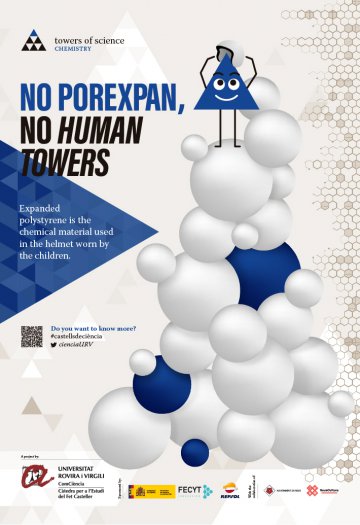
 Because of all the materials produced by various production processes, chemistry has become a necessary part of the world of human towers. One of these materials is plastic and, more specifically, expanded polystyrene (porexpan), which is used to manufacture helmets. This safety feature was introduced in the summer of 2006 and was mandatory for the human-tower builders in the dome (the twos, lifter and crowner) as from 2012.
Because of all the materials produced by various production processes, chemistry has become a necessary part of the world of human towers. One of these materials is plastic and, more specifically, expanded polystyrene (porexpan), which is used to manufacture helmets. This safety feature was introduced in the summer of 2006 and was mandatory for the human-tower builders in the dome (the twos, lifter and crowner) as from 2012.
Expanded polystyrene is also known as white foam or porexpan. It is a foamed plastic material made of 98% air, very light and resistant. It is extremely versatile, 100% recyclable, and can be moulded into many shapes. It is used in food safes, thermal insulation, car chairs, sports helmets and also the helmet worn by the children in the upper tiers of a human tower. It has a considerable capacity to absorb impacts because, when it expands, it deforms and thus absorbs energy. This is how the helmet for tower builders works.
The helmet was by no means straightforward to make, since had to have three features that are not easy to combine: it had to be made with a material that protected the wearer, but which would not harm others in the event of a fall; it had to be an integral part of the uniform and not hinder the practice of tower building, and, finally, it had to be affordable for the groups.
 The effectiveness of the helmet has been proven both scientifically (with data) and socially, since it has helped to consolidate the image of the collective nature of the tower-building world. There is one fact that clearly shows its importance: since it was introduced in 2006, there has not been a single case of traumatic brain injury resulting from a fall. Previously, these injuries were only occasional and generally not serious, but they existed. A study in 2004 showed that in 750 falls there were 24 injuries, 54% of which were head injuries that had some consequences, although not serious.
The effectiveness of the helmet has been proven both scientifically (with data) and socially, since it has helped to consolidate the image of the collective nature of the tower-building world. There is one fact that clearly shows its importance: since it was introduced in 2006, there has not been a single case of traumatic brain injury resulting from a fall. Previously, these injuries were only occasional and generally not serious, but they existed. A study in 2004 showed that in 750 falls there were 24 injuries, 54% of which were head injuries that had some consequences, although not serious.
The successful use of the helmet by the tower builders in the dome has opened up the debate on whether the helmet should also be worn by the builders in the tiers just below the dome in the more challenging constructions such as the 4 by 9 or 3 by 9 without covers.

